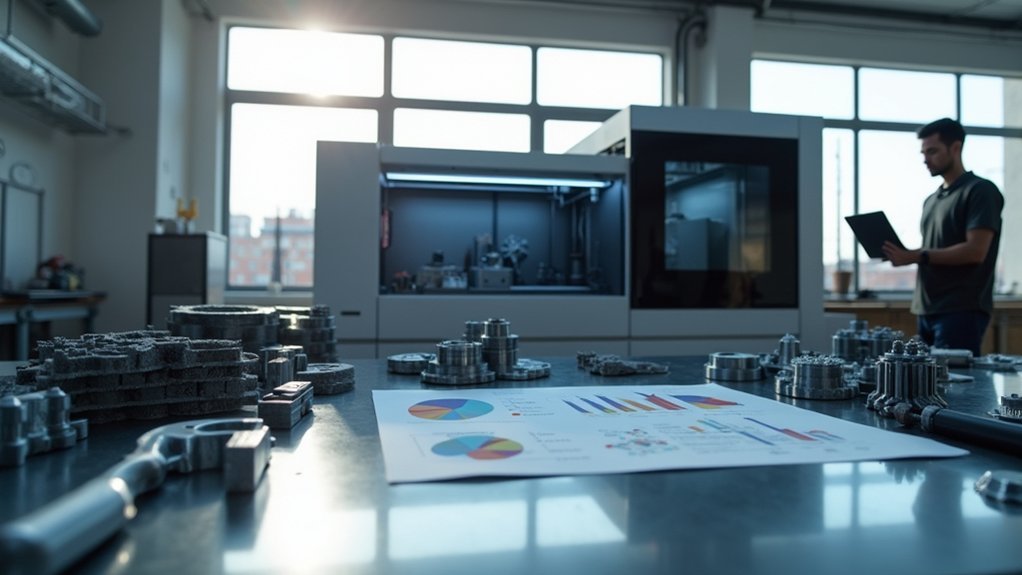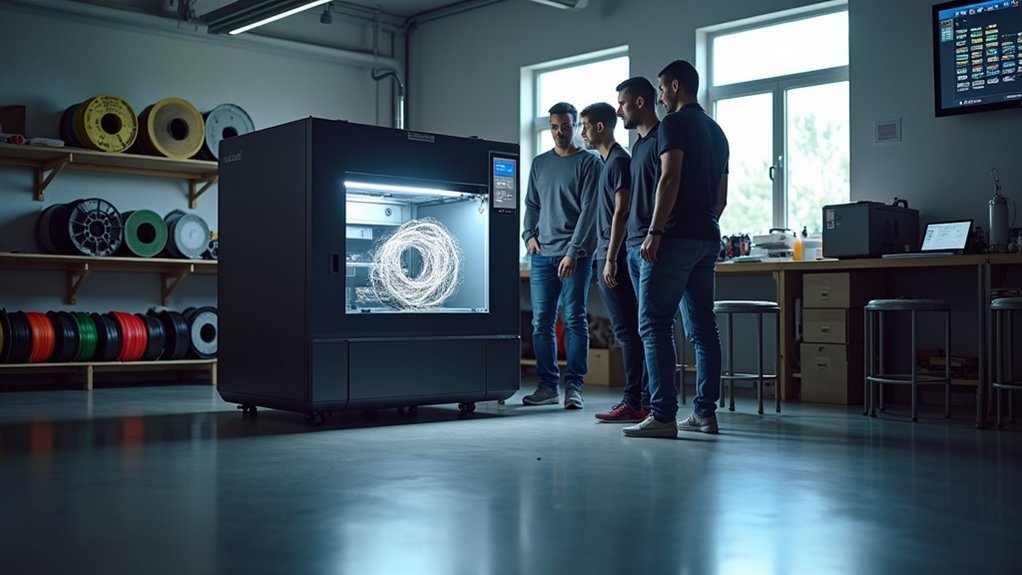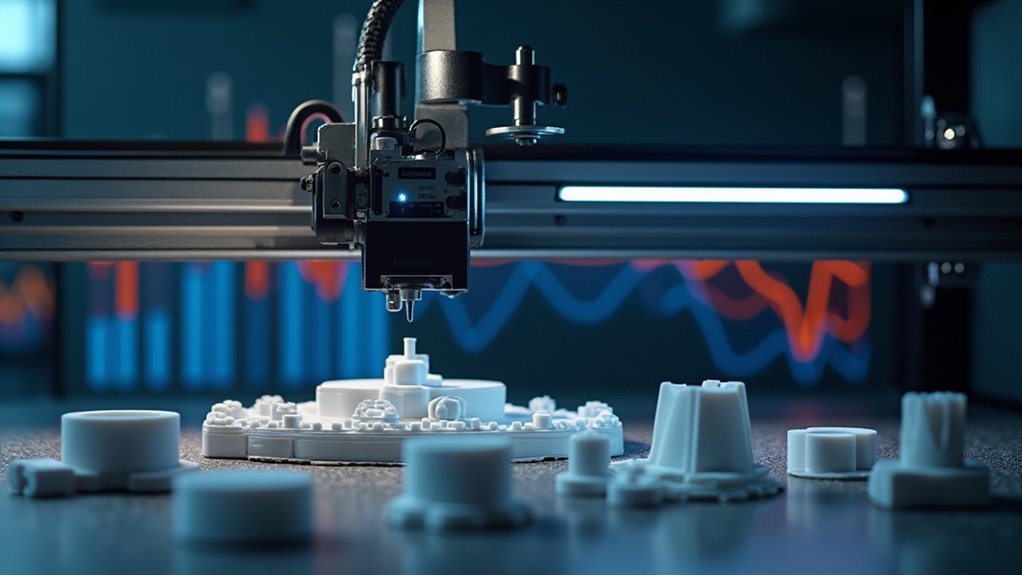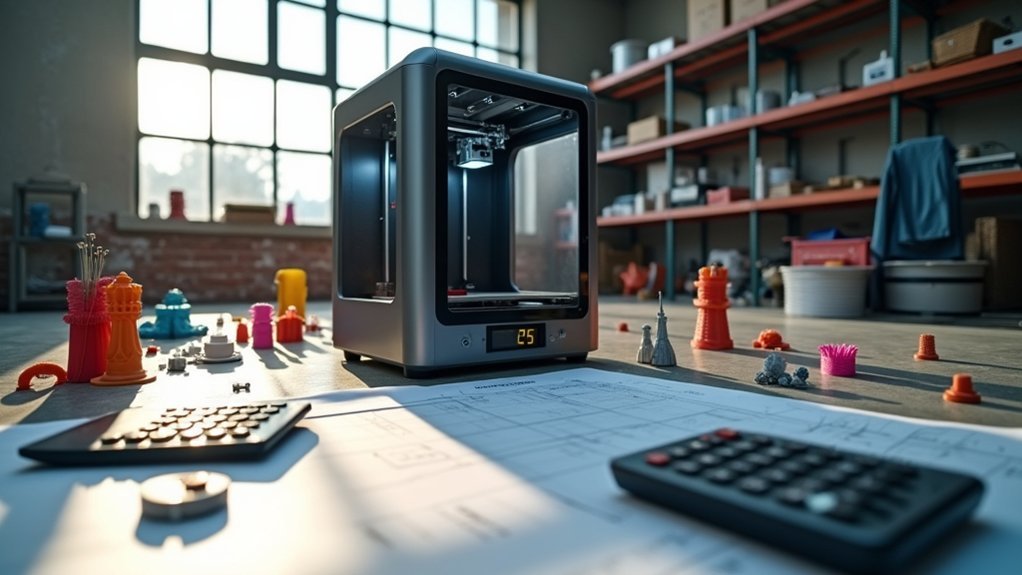You need to calculate industrial 3D printer ROI because outsourcing manufacturing costs are often 40-60% higher than they appear on the surface. Hidden expenses like extended lead times, international shipping fees, and contractor markups can double your per-unit costs while delaying development cycles by weeks. Calculating ROI reveals these true costs and demonstrates how in-house 3D printing can reduce material waste by up to 70%, cut labor costs by 80%, and transform prototype development from weeks to hours, giving you the concrete financial data needed to make informed investment decisions.
Understanding the True Cost of Outsourcing Manufacturing

Why do so many companies underestimate the hidden expenses of outsourced manufacturing?
You’re likely seeing only the surface-level pricing when evaluating external services. That single quoted price doesn’t reveal the complete financial picture you’re facing.
You’ll encounter extended lead times—prototypes can take up to seven days for delivery, considerably slowing your development cycles.
Shipping costs accumulate quickly, especially with overseas production, adding substantial expenses to each order.
International shipping fees can double your per-unit costs while adding weeks to delivery schedules you hadn’t factored into budgets.
External contractors embed markup costs into their pricing, inflating your final expenses compared to internal capabilities.
When you thoroughly analyze these outsourcing expenses, you’ll identify considerable cost savings opportunities.
Investing in your own 3D printing capabilities eliminates shipping delays, reduces markup fees, and provides greater control over your production timeline and budget.
Identifying High-Impact Applications for 3D Printing Investment
Strategic application selection transforms your 3D printing investment from experimental technology into a profit-driving asset.
You’ll maximize returns by evaluating your legacy part files against specific criteria that reveal the most impactful opportunities.
Start by analyzing current outsourcing costs and production timelines for existing components. Focus on high-volume parts where 3D printing can dramatically reduce lead times and labor expenses compared to traditional manufacturing methods.
- Prototyping applications that currently face long outsourcing delays and high per-unit costs
- Manufacturing aids like jigs, fixtures, and tooling that require frequent replacements or modifications
- End-use parts with complex geometries that are expensive to machine traditionally
- Components requiring frequent design changes where 3D printing’s agility provides competitive advantages
This data-driven approach guarantees you’re investing in applications that deliver measurable financial returns.
Calculating Material and Operational Savings With In-House Production

When you calculate your ROI, you’ll need to examine material waste reduction and labor cost analysis as two critical components of in-house production savings.
Material waste reduction occurs because 3D printing’s additive nature uses only the material needed for the part, unlike subtractive manufacturing that cuts away excess material.
Labor cost analysis reveals significant per-unit savings, with studies showing up to 80% cost reductions when you produce parts in-house versus outsourcing them.
Material Waste Reduction
Manufacturing’s traditional subtractive processes create a staggering amount of waste, with some operations discarding up to 70% of their raw materials during production.
When you implement in-house 3D printing, you’ll achieve significant material waste reduction by utilizing only the exact amount of filament needed for each part through additive manufacturing.
Your company can eliminate overproduction entirely with on-demand manufacturing, reducing both waste and holding costs.
You’ll optimize designs specifically for additive processes, using material more efficiently than traditional methods allow.
- Compare material waste volumes between traditional and 3D printing processes
- Calculate savings from reduced inventory requirements and holding costs
- Quantify benefits from eliminating overproduction waste
- Optimize part designs for maximum material efficiency
Labor Cost Analysis
Beyond material savings, your labor costs represent another major opportunity for ROI improvement through in-house 3D printing. When you calculate man-hours required for traditional manufacturing methods, you’ll quantify substantial time savings achievable through rapid prototyping, leading to faster time-to-market.
In-house production eliminates lengthy lead times from outsourced services, letting you respond quickly to project demands and minimize costly delays.
Your true cost of ownership analysis should include labor costs associated with operating traditional manufacturing equipment versus 3D printers, highlighting additive manufacturing’s efficiency.
You’ll also discover that scalable in-house 3D printing operations increase production capacity without proportional increases in labor costs, while eliminating vendor markups and shipping fees that typically inflate outsourcing expenses.
Measuring Time-to-Market Improvements and Development Efficiency
When you’re evaluating 3D printer ROI, you’ll find that measuring time-to-market improvements reveals some of the technology’s most compelling financial benefits.
Your prototype development speed can increase dramatically—what once took days through traditional manufacturing now happens in hours with in-house 3D printing.
This acceleration doesn’t just save time; it transforms your entire product development cycle and gets your innovations to market faster than your competition.
Prototype Development Speed
Speed transforms everything in product development, and industrial 3D printing delivers unprecedented acceleration in prototype creation.
You’ll reduce prototype development speed from weeks to hours, dramatically improving your return on investment (ROI) through faster time-to-market. In-house printing capabilities eliminate shipping delays and enable immediate design iterations, cutting lead times from days to hours.
Your prototype development speed improvements create measurable ROI benefits:
- Accelerated testing cycles – Up to 70% faster validation of design concepts
- Instant iteration capability – Make adjustments and modifications within hours
- Eliminated shipping delays – Local production removes external dependencies
- Reduced tooling costs – Avoid expensive traditional manufacturing setup
This rapid prototyping capability transforms your development timeline, allowing you to test multiple iterations quickly while avoiding costly tooling investments that traditional methods require.
Market Entry Acceleration
Market entry acceleration represents the ultimate payoff of your 3D printing investment, where prototype speed translates directly into competitive advantage.
When you reduce development cycles from weeks to hours, you’re fundamentally transforming your market positioning. Companies like Snow Business showcase this transformation by cutting prototype turnaround from seven days to mere hours, delivering substantial return on investment (ROI) through faster product launches.
Your ability to test multiple design variations quickly means you’ll make better decisions faster, refining products before competitors even finish their first prototype.
This market entry acceleration doesn’t just save time—it captures market share. You’ll reach customers first, establish brand preference, and generate revenue while competitors struggle with lengthy development cycles, maximizing your competitive edge.
Evaluating Quality Benefits and Performance Gains

Although traditional manufacturing methods have dominated industrial production for decades, evaluating the quality benefits and performance gains of 3D printing technology reveals compelling advantages that directly impact your bottom line.
When you’re calculating return on investment (ROI), you can generate concrete data through thorough testing and comparison with legacy part performance to justify your investment in advanced 3D printing technologies.
High-quality 3D printers support diverse materials, enabling you to produce parts with tailored properties for specific applications.
Customer case studies demonstrate that evaluating quality benefits leads to significant cost savings through optimized production processes and reduced external outsourcing.
- Rapid in-house design iteration reduces material waste and enables more testing phases
- Wide material range allows production of parts with desirable, application-specific properties
- Thorough testing provides concrete performance data to justify technology investments
- Optimized production processes minimize outsourcing expenses and improve quality outcomes
Assessing Long-Term Scalability and Growth Potential
When you’re investing in industrial 3D printing technology, evaluating long-term scalability and growth potential becomes critical for maximizing your equipment’s value over time. You’ll need to assess potential increases in print requests from various departments and analyze upcoming projects that may heavily utilize additive manufacturing.
| Timeline | Growth Factor | Considerations |
|---|---|---|
| Years 1-2 | Department adoption | Initial demand patterns |
| Years 3-5 | Project expansion | Production requirements |
| Years 5-7 | Market trends | Technology evolution |
| Years 7-10 | Capacity scaling | Equipment additions |
| Beyond 10 | Strategic alignment | Innovation opportunities |
Establishing a 5-10 year growth perspective guarantees your investments align with anticipated production demands. You can enhance capacity by adding printers as needed, increasing throughput and efficiency. Don’t forget to evaluate your facility layout for expansion opportunities to accommodate new equipment.
Building a Compelling Business Case for Stakeholder Buy-In
Building a compelling business case for industrial 3D printing requires you to present concrete financial data and real-world examples that demonstrate clear value to your organization.
You’ll need to quantify savings from reduced material waste and lower production costs while showcasing specific examples like Snow Business’s dramatic prototype cost reduction from $150 to $3.25 per iteration.
Your return on investment (ROI) calculations should include projected time savings and decreased lead times that show measurable outcomes.
ROI calculations must incorporate projected time savings and reduced lead times to demonstrate quantifiable, measurable business outcomes from industrial 3D printing investments.
- Present concrete ROI calculations with quantified savings from material waste reduction and lower production costs
- Include real-world examples demonstrating dramatic cost reductions in prototyping and manufacturing processes
- Highlight time savings through decreased lead times and faster product development cycles
- Demonstrate scalability potential showing how operations can expand with additional printers as demand increases
Frequently Asked Questions
What Is ROI in 3D Printing?
You’ll calculate ROI in 3D printing by comparing your financial gains from in-house printing against initial costs, measuring production expenses versus traditional methods to determine additive manufacturing’s overall financial impact.
What Is the Profit Margin on a 3D Printer?
You’ll typically see profit margins of 20-30% on 3D printers, but you can boost profitability by bringing production in-house and avoiding outsourcing markups that often exceed 200-300%.
What Is ROI in Printing?
ROI in printing measures your return on investment when you buy 3D printing equipment. You’ll calculate net profits from in-house printing against initial costs, including reduced waste and faster production times.
What Value Does 3D Printing Provide to the Manufacturing Process?
You’ll accelerate product development by reducing prototype lead times from days to hours. You’ll minimize material waste, lower inventory costs through on-demand production, and achieve significant cost reductions per iteration while scaling capacity efficiently.





Leave a Reply